Common types of GIS map applications |
|
|
Release 9.3
Last modified March 23, 2011 |



|
Common types of GIS map applications
It's important to choose a GIS map application suitable for use by your intended audience. The right choice can depend on many factors -- for example:
- Requirements for and the size of the map display window
- The end user's knowledge about GIS
- Intended tasks to be performed
- Administration and application delivery requirements
- Costs to deploy the application
A wide range of GIS map application types can be built and deployed using ArcGIS. Each type of ArcGIS map (or other) application is suitable for certain user audiences and supports selected work flows and user scenarios.
Here's a quick rundown of some common ArcGIS application choices.
ArcGIS Desktop
ArcGIS Desktop provides a rich set of professional GIS applications for map authoring and map use, 3D scene and globe authoring and use, data compilation, analysis and geoprocessing, and publishing of GIS information products for use by others in your organization.
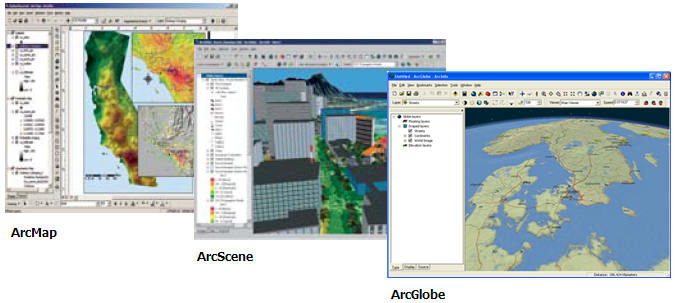
| Usage notes |
|
| Who uses this application type? |
|
| Typical tasks |
|
JavaScript(TM), Microsoft(TM) Silverlight, and Adobe(TM) Flex applications
Using ArcGIS Server, you can develop and deploy Web GIS mashup applications. These simple applications are created as custom applications using JavaScript™, Flex, and Silverlight. They are powered by back-end REST services hosted by ArcGIS Server. In addition, they are easy to program using standard HTML scripting and your choice of simple API's for JavaScript, Adobe Flex, or Microsoft SilverLight. The resulting applications perform very well. They are efficient and scalable.
Web mashup applications are useful for combining map services from any set of map servers. This means that you can mashup your own ArcGIS services with other web services as well as with content from ArcGIS Online, Google Maps™, and Microsoft Virtual Earth™. The only requirement is that the map services to be mashed up must use the same coordinate system.
This application option uses one of a series of web programming API's:
- The ArcGIS JavaScript API
- The ArcGIS FLEX API
- The ArcGIS SilverLight API
Using these, you can embed maps and tasks from any ArcGIS Server into your own custom Web page.
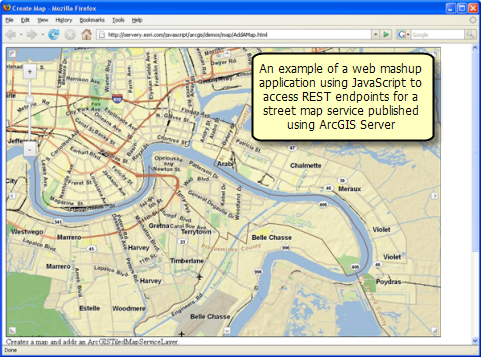
In addition, you can add your own custom GIS tools and buttons to access more advanced GIS functions. In the example below, some simple editing tools have been added to digitize points, lines, and polygons on top of the base map.
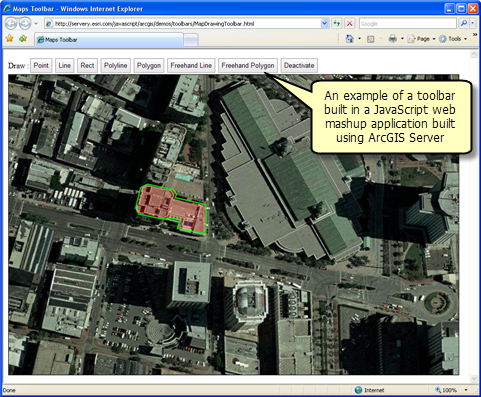
You can also combine your organization's GIS content hosted in ArcGIS Server on top of Google Maps and Microsoft Bing Maps. For example, here is a drive-time calculation accessed from ArcGIS Server mashed up with Google Maps™.
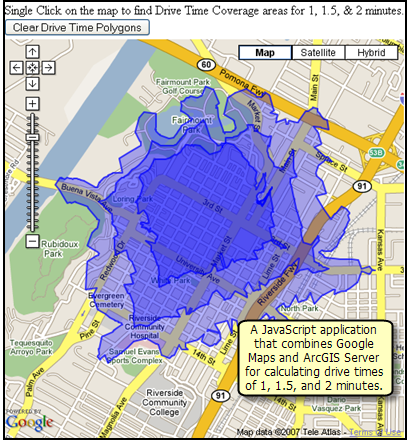
Image courtesy of Google Maps(TM)
Here are some example mash ups in 2D and 3D that mash up GIS data onto Microsoft Bing Maps™.
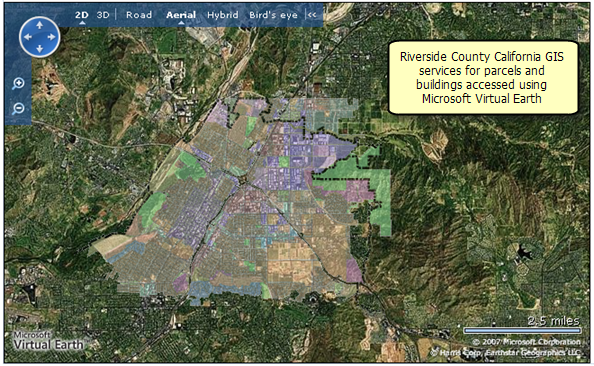
Image courtesy of Microsoft Virtual Earth(TM)
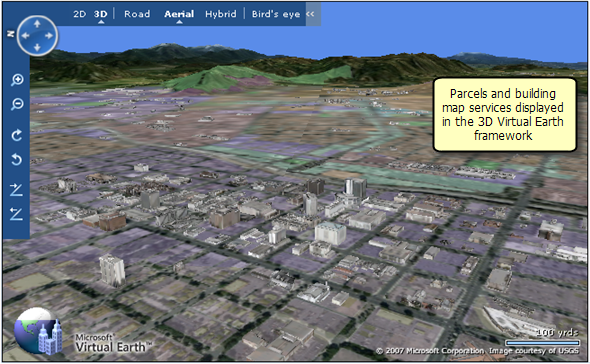
Image courtesy of Microsoft Virtual Earth(TM)
| Usage notes |
|
| Who uses this application type? |
|
| Typical tasks |
|
For more information, see the following links:
- Using the ArcGIS JavaScript API
- Using the ArcGIS Flex API
- Using the ArcGIS SilverLight API
ArcGIS Explorer
ArcGIS Explorer is a free geoexplorer application for use on the Web. ArcGIS Explorer can be used to access a multitude of 2D and 3D base maps, operational layers, and analytical tasks, which are published by the ArcGIS user community.
Using ArcGIS Server, you can author and serve ArcGIS Explorer maps in 2D and 3D as well as publish advanced analytical models and tasks that can be accessed using ArcGIS Explorer.
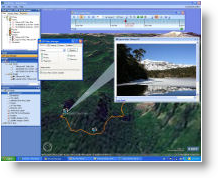
GIS explorer applications utilize 2D and 3D map layers. Most common map use tasks (e.g., geocoding, routing, and query) are supported.
Who uses ArcGIS Explorer?
- Decision makers and executives
- Professional workers with computers on their desks
- Specialists with GIS-based tasks
- Citizens
- Casual GIS users
- Users who want to use a free GIS explorer on their computers
Some common tasks performed with GIS explorers
- Map navigation and visualization of integrated map layers.
- Invoking focused tasks that are hosted on a server (e.g., address geocoding, routing and transportation modeling, accessing server-based GIS modeling and analysis operations).
- For end users who want to explore, visualize, and understand their results, etc.
- Useful for communicating a story line using GIS.
- Can be used for simple edit tasks (e.g., making attribute updates, adding map notes, etc.)
| Supported Web map explorers | Usage notes | Links to more information |
|
Google Earth™
|
|
See KML support in ArcGIS
|
| Microsoft Bing Maps™ |
|
See Using the ArcGIS JavaScript Extension for the Virtual Earth API |
| ArcGIS Explorer |
|
See the ArcGIS Explorer Resource Center
|
Mobile GIS applications
ArcGIS Mobile includes tools for building mobile applications. It includes out-of-the-box mobile applications for Smart Phones, Pocket PC's, and Tablet PC's. ArcGIS Mobile provides field-based access to ArcGIS Server.
A Mobile Developer's Kit for building custom mobile applications is also included.
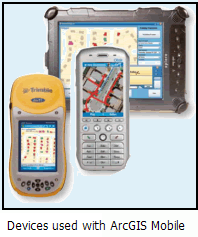
With ArcGIS Mobile applications, you can use mobile devices to:
- View and navigate maps and features
- Collect and update GIS features
- Synchronize the contents in a mobile application with ArcGIS Server (e.g., receive map updates from the server and synchronize field observations and edits with the server).
- Perform field inspection and mobile data collection
| Usage notes |
|
| Who uses this application type? |
|
| Typical tasks |
|
See An overview of ArcGIS Mobile for more information.
The Web Mapping Application included with ArcGIS Server
ArcGIS Server includes a browser-based Web Mapping Application that can be readily deployed using ArcGIS Server. The Web Mapping Application is used to build advanced applications with high-end GIS capabilities for "connected clients." The ArcGIS Web Mapping Application runs inside of most Web browsers and can be customized using either the .NET or Java versions of the Web Application Development Framework (Web ADF).
Here are some example uses of the Web Mapping Application that are included with ArcGIS Server.
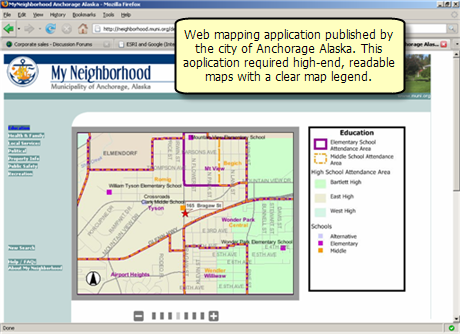
Image courtesy of My Neighborhood, Municipality of Anchorage, Alaska
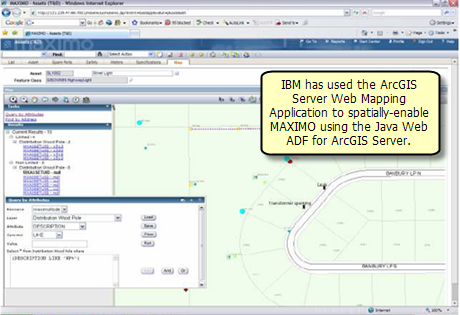
Image courtesy of IBM
Many ArcGIS Server users build custom applications or extend the out-of-the-box Web mapping application using the Web ADF.
-
.NET Web Application Development Framework (ADF). An AJAX-enabled framework for building Web applications built on ASP .Net AJAX. It includes both server side and client side controls and libraries.
-
Java Web Application Development Framework (ADF). Also, an AJAX-enabled framework for building Web applications built on JSF and JEE. It includes server-side controls with client side behavior in JavaScript and libraries that you can use in various Java application development frameworks systems such as Eclipse.
| Usage notes |
|
| Who uses this application type? |
|
| Typical tasks |
|
For more information, see Building Web applications with ArcGIS Server using the Web ADF.
OGC applications
ArcGIS includes support for a range of OGC standards and specifications for web services, including:
- The OGC and ISO simple features specification
- GML
- WMS, including SLD support
- WFS, including WFS-T support
- WCS
- CSW
This enables ArcGIS to openly publish content to many external OGC-centric applications like Gaia. ArcGIS Server can also be used to access and consume OGC Web services within the ArcGIS system for generating map displays, performing data updates, and GIS database management.
For more information on OGC support, see An overview of OGC and ISO support.